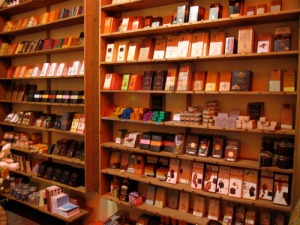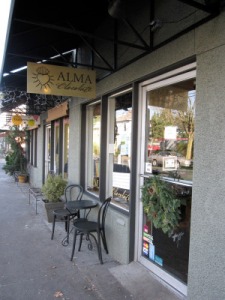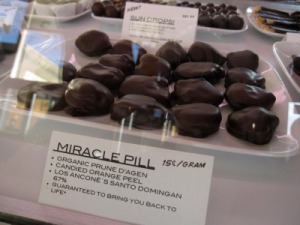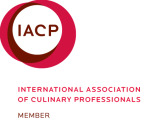I waxed poetic about Claudio Corallo last week. I know you’re busy, being all run-around-y in the sun and all, but it’s worth reading. I promise.
I’ll wait.
…
*twiddling thumbs*
*whistling*
….
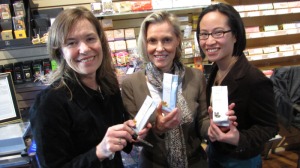
L-R: Hodie Rondeau (Xoxolat), Marie-Francoise Barnhart (Claudio Corallo Chocolate) and, erm, me.
So now that you know who I’m talking about, I can talk about his chocolate and you’ll begin to understand how exceptional it is. We were fortunate enough to be joined by Marie-Francoise Barnhart, who visited us from Seattle with all kinds of goodies in her bag. Among them: a binder of pictures from Claudio’s plantation, with amazing photographs of each step of the chocolate-making process. It was a nice way to bookend the series, as I talked about all the steps in the first class—but the pictures really brought it to life.
Claudio Corallo “raw” cacao beans
As we talked about each step of the chocolate making process, we tried the accompanying product. This included Claudio’s “raw” cacao beans, which are fermented but not roasted. These are commonly referred to as “raw” beans, the “raw” part being a reference to the raw food diet that is so popular right now. (Don’t get me started on what I think about that. Ahem.) The central tenet of raw foodism is that nothing can be heated above 46 degrees Celsius (that’s 115 Farenheit for all y’all Americans). I’d argue that during fermentation, cacao gets much hotter than 46 degrees Celsius, thus negating any of the “raw” food properties that “raw” chocolate is said to embody. Aside from which, most of the “raw” chocolate I’ve tried tastes remarkably like a burnt car tire.
But back to the beans. Claudio’s “raw” cacao beans, all labelling semantics aside, don’t taste like burnt car tire. They taste like a delicately cured olive, with just a hint of tannic pucker and acidity. They don’t taste much like chocolate, aside from a faint nuttiness. They do not taste bad, and they certainly don’t taste bitter. Which is to say that the raw materials that Claudio is starting with are of the utmost quality, and only from top quality beans can you make top quality chocolate.
Claudio Corallo whole cacao beans and 100% bar
From there, we tried whole roasted cacao beans and their crushed variety, cocoa nibs. Most noticeable was the appearance: reddish-brown, and not nearly as dark as most cacao beans or nibs are. Also notable: the complete lack of bitterness. Instead, the cacao beans taste nutty, maybe a bit hoppy, and ever-so-slightly boozy. Claudio’s beans are roasted very lightly, to preserve the delicate flavours. From there, the beans are ground, tempered into thin slabs and hand-cut into bars. And that is the entirety of Claudio’s 100% bar. There’s no sugar added, no fussing around, no further manipulation. And the 100% chocolate? It tastes exactly like the whole roasted cacao beans, but in bar form.
99% of chocolate on the market is conched, which reduces particle size and provides the chocolatemaker a way to fine-tune the flavours. Claudio Corallo refuses to conch his chocolate, as that would drive off the delicate flavours he has worked so hard to retain. Though you’d expect the chocolate to be grainy, it isn’t. I can tell that it’s less refined than other bars, but it certainly isn’t chalky or grainy.
Claudio Corallo “sablé” 80%
“Sablé” means “sandy” en francais and that describes this bar quite well. I hinted in last week’s post that Claudio is a very particular man, and the fact that there are inclusions (that is, bars with stuff in them) is unusual. Where he’s chosen to include something in the bar, it’s been very deliberate and thoughtful.
In this case, he’s taken his 100% chocolate bar and added 20% brown, granular sugar to it. It’s a bit like turbinado sugar, but with finer granules. And on so many levels, it’s brilliant. Most chocolate makers take the ground chocolate bean and add fine granulated sugar to it, then process until the two are indistinguishable. In this case, Claudio has added sugar to his chocolate, but left it in its whole form.
What happens is this: you bite into the bar and taste the 100% chocolate first—nutty, savoury, pungent, wild. And at the split second that your brain starts to expect bitterness, the sugar hits your tongue and bathes it in sticky sweetness. And then your instincts kick in and you start to chew, the sugar crunches against your teeth while the chocolate melts, and then they mix together and it’s bliss.
Claudio Corallo 75%
From there, we tasted the 75% bar. This is 75% of the pure chocolate, with sugar mixed in the traditional way. The result is a bar that, while it contains more sugar than the 80% bar, actually tastes less sweet. The blended-in sugar amplifies certain flavours. This bar tastes distinctly wild. It makes me feel like I’m sitting cross-legged in a damp forest, eating the world’s best chocolate.
Claudio Corallo “soft” 73 1/2%
This one is a bit cheeky in its naming, as it’s a 70% chocolate bar (sugar blended in) with 3 1/2 % cacao nibs scattered on top. It’s called “soft” because the chocolate is softer than the nibs on top. Just as the sugar pulls out a wildness in the 75% bar, the nibs highlight the brightness and nuttiness of the chocolate in this bar. And, the chocolate tastes very sweet when pitted against the nibs, in direct contrast to the 80% bar where the chocolate tasted almost bitter against the grains of sugar. It’s details like that that make me really appreciate how deliberate all these bars are.
This bar is probably one of my favourites for nibbling, and there were definitely a few pairs of eyes rolling backwards into heads when we tasted this.
Claudio Corallo “laranja” (orange)
“Laranja” means orange in Portuguese, and this bar has candied orange peel in it. I’m not usually a fan of candied orange peel: it’s either too sickly sweet or too bitter. In this case, it strikes a nice balance of sweetness without any bitterness, and the chocolate lends itself so well to this elegant flavour combination.
Claudio Corallo “gengibre” (ginger)
This is one of two products in the line that include candied ginger. The ginger is from Thailand, and Claudio candies it himself. Just as with the orange peel, candied ginger is a tricky thing. It needs to strike a balance between candied moistness without being wet, and the ginger must be young and not woody. The addition of candied ginger to Claudio’s chocolate brings out the dark earthiness of the chocolate. The ginger provides a hot, slow burn tempered with sweetness. It’s all very refined; it makes me want to sit up straighter and drink a cup of tea with my pinky sticking out.
Claudio Corallo “ubric” (number 6)
We were so fortunate that Marie-Francoise brought us a sample of this. “Ubric” is a combination of “uva” (raisin) and “briaco” (drunk). Drunken raisins. That’s exactly what’s in this chocolate bar: raisins that have been macerated in pure liquor for who knows how long. The result is that the chocolate melts in your mouth at the precise moment that you register the heat of 100-proof liquor and raisins that, if they were people, would be dancing on tables wearing lampshades. Oh, to be a drunken raisin. Each batch of ubric is slightly different, and number 6 featured a pear liqueur.
Claudio used to make his ubric from the liquor that results from cacao bean fermentation, but the liquor needs to be distilled seven times. Needless to say, it’s very labour-intensive…and I suspect that the spoils of that project are for Claudio’s enjoyment.
Claudio Corallo ginger spheres
I have always called these ginger balls, and of course that makes me giggle. I’m giggling right now, and I suspect that you are too.
Ginger balls. Ginger balls! Ginger balls.
Anyway. I have always called these ginger balls, because that’s how they were introduced to me, but Marie-Francoise is proper and French and she calls them ginger spheres. Ginger spheres are chunks of the aformentioned Thai ginger, candied, and covered in 100% chocolate. The thing is that you have to warm the, erm, spheres up in your hand before eating them, and then you need to chew. Chew furiously and enjoy the moist and meaty chunk of ginger as it melds with 100% chocolate. Though it’s the same ingredients as in the “gengibre” bar, it’s brash and almost obnoxious. Claudio likes to bookend the experience with a small piece of 100% chocolate.
Claudio Corallo coffee beans
Before growing cacao on Sao Tome and Principe, Claudio was a coffee grower in the Congo (then Zaire). He’s taken to growing small crops of arabica on Sao Tome, and he took three batches of coffee beans and covered them in 60% chocolate. They’re all the same strain of coffee, but grown in different places on the island. And each of them tastes astonishingly different. #1, as it is cleverly called, is espresso-like. It’s robust and brash and overpowers the chocolate. #2 is more subtle. The coffee is mellow and builds gradually in strength, then has a long finish that lingers in your mouth for several minutes. Finally, #3 has a nice balance of coffee and chocolate, highlighting both equally.
Use your nose
I’m the first to admit that Claudio’s packaging is intimidating. It’s all space-age looking and you have no idea what you’re getting inside. However, the benefit of the spacey packaging is that the chocolate is completely sealed from the outside. This means that when you open it, you’re in for a completely singular experience. Find a quiet place. Get the package and a pair of sharp scissors. Make a clean cut at the top of the bag, and stick your nose in it. Breathe deeply. I can only tell you how divine it smells, like the chocolate is excited to meet you and can’t wait for you to taste it.
This is an experience that can and should be shared, but it does require a quiet moment, a bit of reverence, and someone who will appreciate food that makes you make faces that are usually made in the privacy of one’s bedroom.


